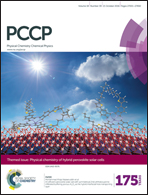Magnetomigration of rare-earth ions in inhomogeneous magnetic fields†
Abstract
The effects of external inhomogenous (gradient) magnetic fields on the movement of the rare-earth ions: Dy3+, Gd3+ and Y3+, in initially homogeneous aqueous solutions have been investigated. Differences in the migration of rare-earth ions in gradient magnetic fields were observed, depending on the magnetic character of the ions: paramagnetic ions of Dy3+ and Gd3+ move towards regions of the sample where the magnetic field gradient is the strongest, while diamagnetic ions of Y3+ move in the opposite direction. It has been showed that the low magnetic field gradients, such the ones generated by permanent magnets, are sufficient to observe the magnetomigration effects of the ions in solution. The present work clearly establishes the behavior of magnetically different ions in initially homogeneous aqueous solutions exposed to magnetic field gradients. To this avail, a methodology for measuring the local concentration differences of metal ions in liquid samples was developed.


 Please wait while we load your content...
Please wait while we load your content...